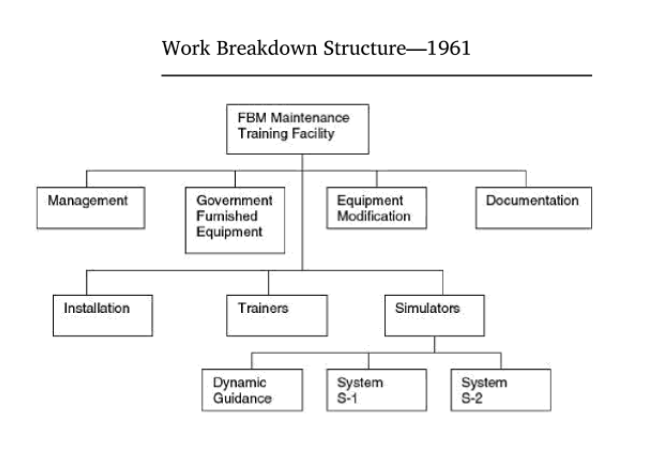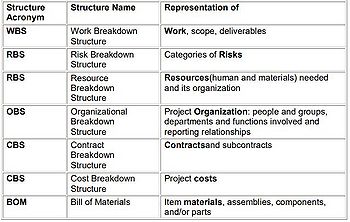The Work breakdown structure(WBS)
| Line 83: | Line 83: | ||
=== 100% Rule === | === 100% Rule === | ||
Everything that needs to be accomplished by the WBS is defined by the 100% rule. | Everything that needs to be accomplished by the WBS is defined by the 100% rule. | ||
| + | |||
When creating and organizing a WBS it is critical to follow the 100% rule. | When creating and organizing a WBS it is critical to follow the 100% rule. | ||
The rule is stated and defined as follows: | The rule is stated and defined as follows: | ||
| − | The 100% rule | + | The 100% rule (Haugan, 2002, p 17) is a core characteristic of the WBS. This rule states that the WBS includes 100% of the work defined by the project scope and captures ALL deliverables—internal, external, and interim—in terms of work to be completed, including project management. The 100% rule is one of the most important principles guiding the development, decomposition and evaluation of the WBS. The rule applies at all levels within the hierarchy: the sum of the work at the ‘‘child’’ level must equal100% of the work represented by the ‘‘parent’’ and the WBS should not include any work that falls outside the actual scope of the project, that is, it cannot include more than 100% of the work. It is important to remember that the 100% rule also applies at the activity level. The work represented by the activities in each work package must add up to 100% of the work necessary to complete the work package. |
By using the rule as stated above, it allows a project manager to have a good overview of each branch of the WBS and good vision of the entire project. | By using the rule as stated above, it allows a project manager to have a good overview of each branch of the WBS and good vision of the entire project. | ||
Revision as of 17:33, 26 February 2021
Contents |
Introduction
According to ISO 21500 a project is defined as “ a unique set of processes consisting of coordinated and controlled activities with start and finish dates, undertaken to achieve an objective”. However a project can consist of various variety of different things and become very complex. To be able to simplify the complexity of a project it is important to have a clear scope of what the project is about and what it consists of. The complexity of a project can for example be governed by involvement of different parties or stakeholders, time estimations and cost. The best way of an organized work and smoothly managed project is to break the work down into smaller segments of the bigger pictures. The work breakdown structure model is often used for that [1] .
A well defined project has a clear scope. Breaking the scope down into smaller segments can make a large project more manageable and easier to work with, this is the separating phase. When the separation has been done it is important that each separated segment is integrated so it can work. Even with well organized project, it can change throughout the timeline and it is important to adapt to any evolvement or changes.
The origin of the WBS
It is hard to imagine that large and complex projects can be conducted with out well organize scope that has been broken down into smaller segments( pices, components). However in 1959 there was a paper published that described a new technique called PERT or “ Program Evaluation and Review Technique”[2]. This new technique was developed for the Program Evaluation Branch of the Special Project Office of the US. Navy. The reason for the development of this technique was because the Special office was concerned about certain plans such as missile guiding systems, weapons and ships[3]. Even though this technique was not specifically described as the WBS it had similar structure and theory as we know the WBS today. It was not until 1961 where the term work breakdown structure became the known term for the model [2]. The department of Defense ( DOD) in cooperation with NASA and aerospace industry created and published a document that had much more detailed use and description which describes the WBS. The model was used much in the coming years primarily for government or military usage. In 1987 WBS was first used by the Project management institute in a non governmental or milatery way and started to be used in businesses and other organizations around 1993. [4].
Concept
Overview
Work breakdown structure is a model that was developed to breakdown the work of a project into smaller pieces to have a more specific and detail scope that is well defined. WBS is often mistaken for the tasks that needs to be done, but that statement is incorrect. It is what is needed to be delivered. The model was specifically designed to assist people that are connected to a project, in a way that the outcome of a project is more visible and clearer. The WBS can be very affective tool and if made right the framework should consist of the entire deliverables of a project [5]. The model itself is structured in a way where the upper part is usually the major deliverables work segment of a project. By dividing the project in the major phases, the project manager can benefit tremendously, it can help him organize and create a specific team that suits each major factor as well as having better overview of the teams and progress. Creating a team can be difficult and can be a key factor in achieving set goals. The lower part of the model usually consists of more detailed parts of each major phase. That is the scope becomes more visible and planning can start in more effective way such as creating timelines and making cost estimation. The top and bottom parts of the WBS are smaller segments of the entire project that combine and work together and create the final outcome of the project.
Who can use the WBS
As stated above in the overview chapter, the U.S Department of Defense used and still uses the WBS. The projects can be of an enormous size and huge complexity as well as smaller sized project. Even though the model is used in complex projects such as the navy or NASA have, the WBS can be used for smaller ones as well. The model is not structured for any specific projects on the contrary, it is designed to function as a tool for project of any variety. It can for example help construction projects, such as building a house, or software developers designing new software or even a person who has a project connected to them selves in their personal life. The structure and concept of WBS is usually the same despite different industries or projects, the only difference are the deliverables and how they are proceeded. The main goal for every project is to succeed, what ever the project is and the WBS can be used for that.
Creating WBS
It can be difficult to realize when or how to create the work breakdown structure even when knowing how to use it. The most important part when creating the projects WBS is to have some initial scope structure of the project that is to be undertaken. A requirements document is important as well, where the goals and purpose are defined. However these things can often be created and evolved while the scope of the project is being defined. It is important to have as much information about the project work in the beginning stages of the project. The WBS is used throughout the duration of the project from the beginning phase to the end phase. Useful structural points of the model to reflect on while a project is ongoing are as stated below:
• Create
• Refine
• Use
• Verify
In the creation of the model, the project manager is one of the key members in creating it. However, it is crucial that the project manager and the management team work closely together and involve the stakeholders as well as experts or other personnel that will be working on the project or have experience of similar project to help with the creation of the WBS. There are various ways of how to create and structure a good WBS model. When creating the WBS the project manager needs to be familiar with the concept and the model itself. The reason for that is because there are a lot of models that have very similar structure as the WBS but are not providing the same information and do not serve the same purpose. It is therefore important that all of those who are associated with the WBS have a good knowledge of what it is or at least that they are presented with a “rightly” done model. It is common that people are mistaken of the different models, for example the risk breakdown structure (RBS). The RBS is used to breakdown different sections of risk in to smaller categories. That is for example, external risk for the larger section and smaller sections can consist of how the external risk can appear in any way. Though the structure and the idea is similar as the WBS it is not the same.
The most common mistakes of similar tools are illustrated in the table 1:
100% Rule
Everything that needs to be accomplished by the WBS is defined by the 100% rule.
When creating and organizing a WBS it is critical to follow the 100% rule. The rule is stated and defined as follows: The 100% rule (Haugan, 2002, p 17) is a core characteristic of the WBS. This rule states that the WBS includes 100% of the work defined by the project scope and captures ALL deliverables—internal, external, and interim—in terms of work to be completed, including project management. The 100% rule is one of the most important principles guiding the development, decomposition and evaluation of the WBS. The rule applies at all levels within the hierarchy: the sum of the work at the ‘‘child’’ level must equal100% of the work represented by the ‘‘parent’’ and the WBS should not include any work that falls outside the actual scope of the project, that is, it cannot include more than 100% of the work. It is important to remember that the 100% rule also applies at the activity level. The work represented by the activities in each work package must add up to 100% of the work necessary to complete the work package.
By using the rule as stated above, it allows a project manager to have a good overview of each branch of the WBS and good vision of the entire project.
Why use WBS
EXAMPLE
EXAMPLE
references
- ↑ L. Buchtik, Secrets to mastering the WBS in real-world projects, (Project Management Institute, 2010), 13-14.
- ↑ 2.0 2.1 G.T.Haugan, "Effective Work Breakdown Structures",(Berret-Koehler Publishers, Inc. 2001 ).
- ↑ "Application of technique for research and development program evaluation",(http://mech.vub.ac.be/teaching/info/Ontwerpmethodologie/Appendix%20les%202%20PERT.pdf/), Accessed: 2021-2-18.
- ↑ " Getting Started with work breakdown structure(WBS)",(”https://www.smartsheet.com/getting-started-work-breakdown-structures-wbs#:~:text=The%20term%20%E2%80%9Cwork%20breakdown%20structure,Structure%20(WBS)%20Practice%20Standard/), Accessed: 2021-2-18.
- ↑ "Practce Standard for Work Breakdown Structure- second Edition",(Project Management Institute, Inc. 2006), 5-7.

